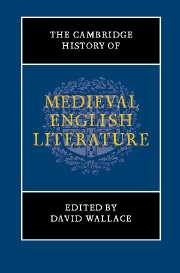Book contents
- Frontmatter
- I AFTER THE NORMAN CONQUEST
- II WRITING IN THE BRITISH ISLES
- Introduction
- 7 Writing in Wales
- 8 Writing in Ireland
- 9 Writing in Scotland, 1058–1560
- 10 Writing history in England
- 11 London texts and literate practice
- III INSTITUTIONAL PRODUCTION
- IV AFTER THE BLACK DEATH
- V BEFORE THE REFORMATION
- Chronological outline of historical events and texts in Britain, 1050–1550
- Bibliography
- Index of manuscripts
- Index
- References
9 - Writing in Scotland, 1058–1560
from II - WRITING IN THE BRITISH ISLES
Published online by Cambridge University Press: 28 March 2008
- Frontmatter
- I AFTER THE NORMAN CONQUEST
- II WRITING IN THE BRITISH ISLES
- Introduction
- 7 Writing in Wales
- 8 Writing in Ireland
- 9 Writing in Scotland, 1058–1560
- 10 Writing history in England
- 11 London texts and literate practice
- III INSTITUTIONAL PRODUCTION
- IV AFTER THE BLACK DEATH
- V BEFORE THE REFORMATION
- Chronological outline of historical events and texts in Britain, 1050–1550
- Bibliography
- Index of manuscripts
- Index
- References
Summary
We could only include the present chapter in a history of ‘English’ literature through a catachresis that risks imposing a distorted perspective on Scottish history and culture. If the title of the present section displays its good intentions by using the more inclusive term ‘British Isles’, the volume none the less insists on a problematic choice of dates, for neither the Battle of Hastings nor the dissolution of the English monasteries is of direct consequence to Scotland, which remained an independent kingdom of international significance throughout the Middle Ages. The following chapter therefore begins with the reign of Malcolm III (‘Canmore’) and concludes with the Reformation Parliament. By beginning and ending with Gaelic materials, moreover, the chapter points to a two-fold opposition between Lowlands Scots and Gaelic culture on the one hand, and Scotland and England on the other.
The medieval kingdom of the Scots brought many peoples and language groups into an often fragile association. The ninth-century assimilation of the Pictish kingdom in the north-east provided a stable territorial base for more recent additions to the expansionist kingdom, including the satellite British (Cumbric) kingdom of Strathclyde and the Anglian-speaking territory of Lothian south of the Firth of Forth. In the opening years of our survey, however, the Western and Northern Isles still remained under Norse control: the Hebrides were not officially ceded until the Treaty of Perth in 1266; the Orkney and Shetland Islands followed in 1468–9.
- Type
- Chapter
- Information
- The Cambridge History of Medieval English Literature , pp. 229 - 254Publisher: Cambridge University PressPrint publication year: 1999
References
Accessibility information
- 4
- Cited by

